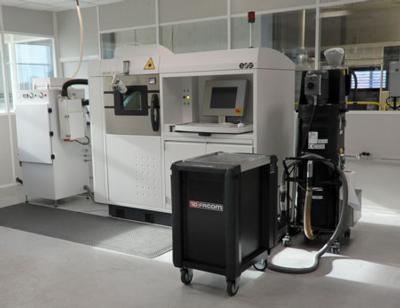Fri, Jan 16, 2015
Fuel Injector Nozzles Being Made Using Selective Laser Melting Techniques
Helicopter engine manufacturer Turbomeca is setting up new manufacturing capability at its facility in Bordes (France). After years of maturation and prototype testing, Turbomeca has entered serial production of parts using the latest additive manufacturing, or 3D printing process. Bordes facility is one of the first of its kind to serial produce additive components for aerospace propulsion industry in France.

Arrano test and production engines will feature fuel injector nozzles made using Selective Laser Melting (SLM) techniques. This leading-edge manufacturing process will also be used to manufacture Ardiden 3 combustor swirlers. These engines are Turbomeca’s latest models and amongst the most advanced turboshafts ever designed.
Additive manufacturing produces parts to a three-dimensional CAD (computer-aided design) model. Unlike traditional manufacturing processes (forging and machining) which are based on material removal, additive manufacturing builds layers, each between 20 and 100-micrometers thick, of fine metal powder to produce complex-shape parts. In the case of SLM, a computer-controlled laser shoots pinpoint beams onto a bed of nickel-based super-alloy powder, to melt the metal in the desired areas.

Additive Manufacturing also simplifies the manufacturing process. A traditional fuel-injector nozzle is made up from dozens different pieces. Arrano component is made from one single piece of material and features advanced injection and cooling functions. One SLM machine is already in service, and qualified for mass production, with others to be integrated over the coming years.
Additive manufacturing is part of Turbomeca’s ambitious “Future Line” program designed to improve all its manufacturing capabilities. By introducing new, high-end machine tools and new processes like additive manufacturing and HVOF (High Velocity Oxy-Fuel) coatings, Turbomeca will significantly improve its compressor and turbine blade manufacturing capabilities at Bordes.
(Images provided by Turbomeca)
More News
From 2023 (YouTube Edition): "Ain’t Your Daddy’s Super Cub”—Don Wade Co-owned by Don and Ron Wade—the former of Don’s Dream Machines, a storied >[...]
Pilot-Rated Passenger Reported That The Pilot Did Not Adequately “Round Out” The Landing Flare And The Airplane Bounced And Yawed To The Right Analysis: The pilot state>[...]
Dead Reckoning Dead reckoning, as applied to flying, is the navigation of an airplane solely by means of computations based on airspeed, course, heading, wind direction, and speed,>[...]
Aero Linx: Lake Amphibian Club This website is created and sponsored by the Lake Amphibian Club, to help spread the word about these wonderful, versatile amphibians that can land j>[...]
“I am deeply honored to be sworn in as NASA administrator. NASA’s mission is as imperative and urgent as ever — to push the boundaries of human exploration, ignit>[...]
 Classic Aero-TV: In Praise of Alabamas Patriot Aircraft USA
Classic Aero-TV: In Praise of Alabamas Patriot Aircraft USA NTSB Final Report: Cirrus Design Corp SR22
NTSB Final Report: Cirrus Design Corp SR22 ANN's Daily Aero-Term (12.21.25): Dead Reckoning
ANN's Daily Aero-Term (12.21.25): Dead Reckoning ANN's Daily Aero-Linx (12.21.25)
ANN's Daily Aero-Linx (12.21.25) Aero-News: Quote of the Day (12.21.25)
Aero-News: Quote of the Day (12.21.25)




